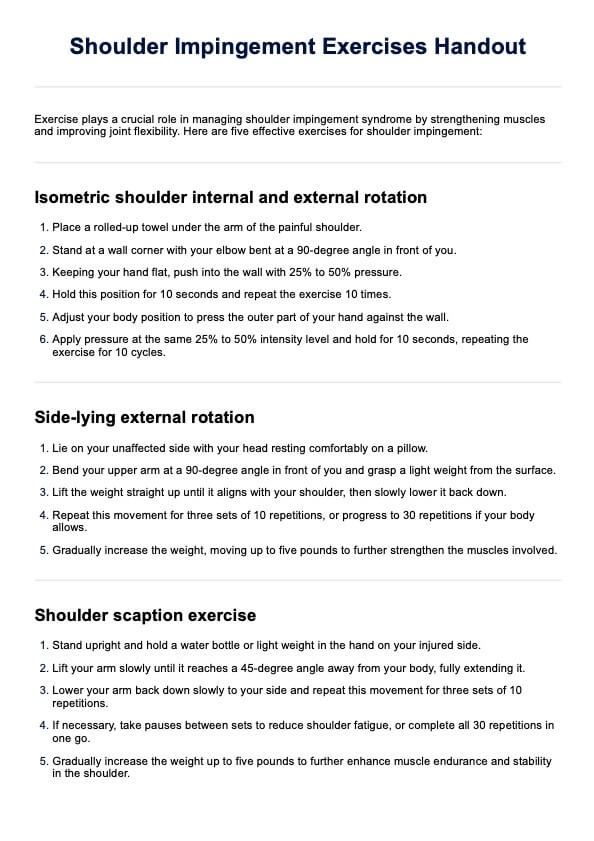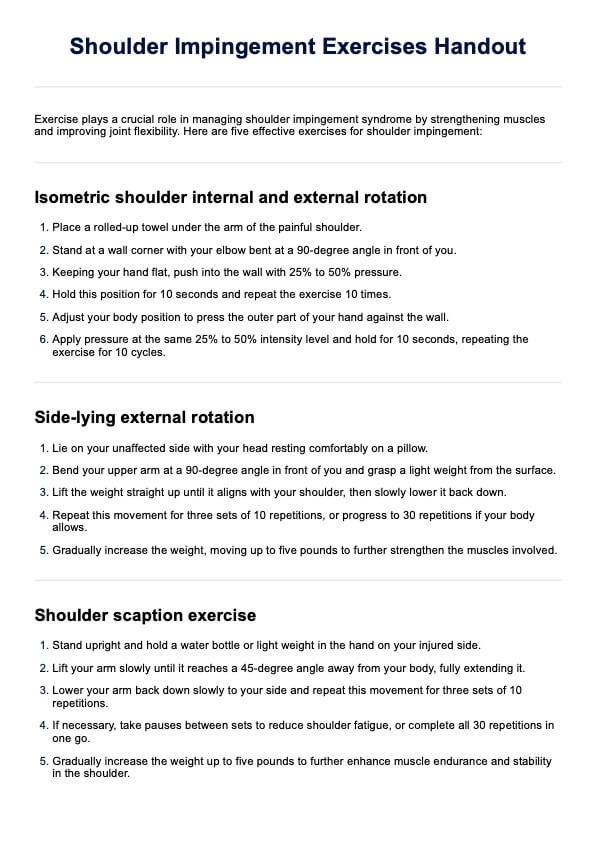Shoulder Impingement Exercises Handout
Download Carepatron's free PDF handout with shoulder impingement exercises and examples to help alleviate pain and improve shoulder strength.


What is shoulder impingement?
Shoulder impingement syndrome occurs when the tendons of the rotator cuff muscles and the bursa within the shoulder joint become compressed and irritated. This condition typically leads to pain and inflammation, especially during overhead movements or activities that involve raising the arm. The rotator cuff, consisting of four muscles and their tendons, plays a crucial role in stabilizing the shoulder joint and facilitating various arm movements.
Symptoms of shoulder impingement
Common indicators include persistent shoulder pain, especially during activities that involve raising the arm, such as reaching overhead or behind the back. Individuals may also experience discomfort when sleeping on the affected side or while performing tasks that require arm movements above shoulder level.
The pain associated with shoulder impingement tends to localize around the shoulder joint and may radiate down the arm. Some people notice weakness in the affected arm, particularly when lifting objects or performing repetitive motions. Swelling and tenderness around the shoulder blades or along the front and side of the shoulder are also typical signs of shoulder impingement syndrome.
Causes of shoulder impingement
The primary cause of shoulder impingement is repetitive overhead motions, such as those required in sports like tennis or activities like painting or lifting. When the space between the acromion (a part of the shoulder blade) and the rotator cuff tendon narrows, it can pinch the tendons and bursa, resulting in discomfort and limited mobility. Individuals with shoulder impingement often experience pain on the affected arm straight, particularly when reaching upwards or behind the back.
Shoulder Impingement Exercises Handout Template
Shoulder Impingement Exercises Handout Example
How do physical therapists address shoulder impingement?
Physical therapists play a crucial role in managing shoulder impingement by employing various techniques and therapies tailored to each individual's needs. Here’s how they typically approach treatment:
Therapeutic exercises
Physical therapists prescribe specific exercises to strengthen the rotator cuff muscles and improve shoulder joint stability. These exercises often include stretching and strengthening routines focused on enhancing range of motion and reducing pain associated with shoulder impingement.
Manual therapy
Manual therapy techniques such as joint mobilizations and soft tissue manipulation are used to alleviate pain and improve shoulder mobility. These hands-on approaches can help reduce inflammation, release tight muscles, and restore normal shoulder mechanics.
Postural education and modifications
Educating patients about proper posture and ergonomics is essential in managing shoulder impingement. Physical therapists provide guidance on maintaining correct body alignment during daily activities and work-related tasks to prevent exacerbating shoulder pain.
5 examples of Shoulder Impingement Exercises
Exercise plays a crucial role in managing shoulder impingement syndrome by strengthening muscles and improving joint flexibility. Here are five effective exercises for shoulder impingement recommended you can demonstrate for your patients:
Isometric shoulder internal and external rotation
Begin by placing a rolled-up towel under the arm of the painful shoulder. Stand at a wall corner with your elbow bent at a 90-degree angle in front of you. Using your palm, gently press against the wall at around 25% to 50% of your maximum effort. Hold this position for 10 seconds, repeating the exercise 10 times. This action constitutes the internal rotation phase.
Next, adjust your body position to press the outer part of your hand against the wall. Apply pressure at the same 25% to 50% intensity level and hold for 10 seconds, repeating the exercise for 10 cycles. This constitutes the external rotation phase.
Side-lying external rotation lie
Lie on your unaffected side with your head resting comfortably on a pillow, maintaining a neutral position. Bend your upper arm at a 90-degree angle in front of you and grasp a light weight (Hershfield suggests starting with a one-pound water bottle) from the surface. Lift the weight straight up until it aligns with your shoulder, then lower it slowly back down. Repeat this movement for three sets of 10 repetitions, or progress to 30 repetitions if your body allows. Over time, you can gradually increase the weight, moving up to five pounds to further strengthen the muscles involved.
Shoulder scaption exercise
Stand upright and hold a water bottle or light weight in the hand on your injured side. Lift your arm slowly until it reaches a 45-degree angle away from your body, fully extending it. Lower your arm back down slowly to your side and repeat this movement for three sets of 10 repetitions. If necessary, take pauses between sets to reduce shoulder fatigue, or complete all 30 repetitions in one go. As your strength improves, gradually increase the weight up to five pounds to further enhance muscle endurance and stability in the shoulder.
Scapula push and pull
In a standing position, hold a resistance band with both hands at chest height. Pull the band apart, squeezing your shoulder blades together (scapula pull). Hold briefly, then release slowly. Next, push the band forward, spreading your shoulder blades apart (scapula push). Do repetitive overhead movements for several repetitions, focusing on maintaining good posture throughout.
Scapula squeeze
Sit or stand with your arms by your sides and elbows bent to 90 degrees. Squeeze your shoulder blades together as if trying to hold a pencil between them. Hold this position for a few seconds, then relax. Repeat for multiple sets. This exercise helps improve scapular stability and posture, reducing the risk of shoulder impingement.
How this handout benefits physical therapists
This handout provides valuable exercises and guidelines that can significantly benefit physical therapists in their treatment of patients with shoulder issues. Here are three key benefits:
Comprehensive exercise instructions
The handout offers clear and structured instructions for a variety of shoulder exercises, including the crossover arm stretch, chest stretch, and resistance band exercises. These exercises target essential muscle groups such as the biceps, pectoral muscles, and those involved in shoulder extension.
Customizable rehabilitation programs
With a range of exercises and variations, the handout allows physical therapists to tailor rehabilitation programs to individual patient needs. Therapists can select exercises based on the patient's specific symptoms, range of motion, and recovery goals.
Education and patient empowerment
Beyond exercise instructions, the handout serves as an educational tool for patients. By explaining the purpose and benefits of each exercise, physical therapists empower patients to take an active role in their recovery.
Commonly asked questions
Rest, avoid activities that aggravate the shoulder, and follow a physical therapy program tailored to strengthen the rotator cuff muscles and improve shoulder mechanics.
Exercises that strengthen the rotator cuff and scapular stabilizers, such as external rotation with a resistance band and scapular squeezes, are beneficial for improving shoulder function.
Gentle stretching of the chest muscles (pectoral muscles) and shoulders can help alleviate tightness and improve flexibility, but avoid aggressive stretching that exacerbates pain.
With appropriate treatment, including physical therapy, modification of activities, and strengthening exercises, many individuals can reduce symptoms and improve shoulder function over time. However, complete reversal depends on the severity and underlying causes of the impingement.







































































































